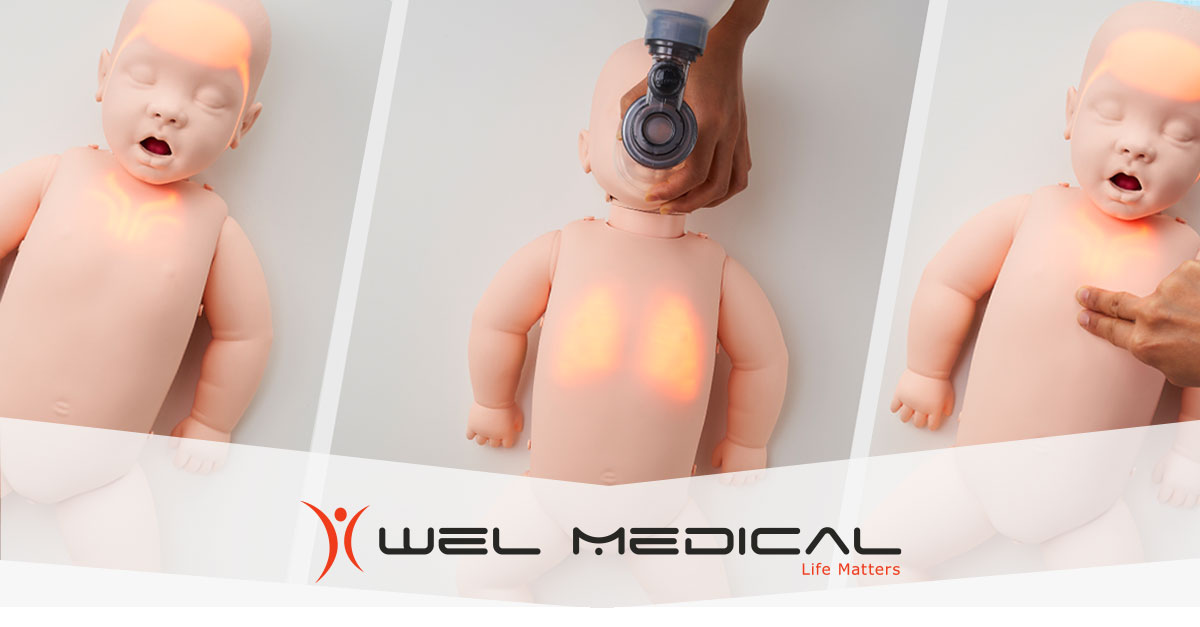[vc_row full_width=”stretch_row”][vc_column][layerslider_vc id=”29″][/vc_column][/vc_row][vc_row padding_top=”20px” padding_bottom=”20px”][vc_column width=”1/3″][vc_single_image image=”1905″ img_size=”full”][/vc_column][vc_column width=”2/3″][vc_column_text]What are Baby Brayden CPR Manikins?
The Award-Winning Brayden CPR Manikins present a highly innovative and effective way to teach and learn both the “how-to” and “why to” perform CPR. Its unique features mean that it is the first-ever manikin to allow users to visualise the effects of CPR.
Brayden was initially designed and developed by the team at Innosonian Inc. Based in Korea, the team are a group of trailblazers! Designers and engineers with a real pedigree. CEO, Moley Chung, was previously the General Manager of CU Medical Systems, the manufacturer of iPAD defibrillators, so he is passionate about developing products that can help people perform lifesaving skills, along with his in-house team being equally as passionate.
WEL Medical Partnership
WEL Medical carried an excellent relationship forward with Mr Chung from his time at CU Medical to Innosonian Inc and was the first to be shown the prototype of the CPR Brayden Training Manikin. In 2014, WEL Medical took responsibility for the launch of Brayden’s high-quality CPR Manikins in the UK and Ireland.
Mr Chung had the idea for the Brayden Manikin to address some of the challenges raised by research directly. It showed that CPR skills after training were poor due to lacking retention of knowledge and fear of causing harm. This is where he set about to develop a method visually demonstrating the effects of CPR.
Features
Brayden CPR resuscitation manikins are equipped with three sets of interrelated LED lights that illuminate in direct relation to the depth and rate of compressions, clearly illustrating the overall quality of the CPR being performed.
Seeing how CPR is having a direct effect on the flow of oxygenated blood to the brain increases the speed at which skills can be both learned and retained. This ultimately increases confidence and competence in CPR skills.
Reception
Brayden’s award-winning CPR manikins have been exceptionally well received and have proven to be a highly effective CPR training manikin in the UK. Dr Carl Gwinnutt, Emeritus Consultant, Salford Royal Hospitals NHS Foundation Trust, said:
“The ERC 2015 Guidelines for Resuscitation identify the usefulness of feedback from devices during CPR training as a way of improving trainees’ skill acquisition and retention. The Brayden manikin achieves this innovatively and effectively, allowing trainers to assess objectively whether chest compressions are being delivered in accordance with recommendations, rather than simply relying on making a subjective estimation.”
Professor Douglas Chamberlain said:
“This training manikin is a useful addition to those currently available. The light effects to show likely sufficient coronary and cerebral flows is novel and will be an effective stimulus for improving the quality of compressions.”
Click here to shop our range of Brayden CPR Manikins.
VISIT THE BRAYDEN WEBSITE[/vc_column_text][/vc_column][/vc_row][vc_row padding_top=”20px” padding_bottom=”20px” bg_type=”bg_color” bg_override=”full” bg_color_value=”#f5f5f5″][vc_column width=”1/4″][vc_single_image image=”1896″ img_size=”full” css=”.vc_custom_1557242834664{border-radius: 10px !important;}” el_class=”panel”][vc_column_text]The non-toxic materials are soft and smooth to represent an infant’s skin.[/vc_column_text][/vc_column][vc_column width=”1/4″][vc_single_image image=”1897″ img_size=”full” css=”.vc_custom_1557240260237{border-radius: 10px !important;}” el_class=”panel”][vc_column_text]The Baby Brayden manikin has an open and interconnected mouth and nose which adds realism when ventilating.[/vc_column_text][/vc_column][vc_column width=”1/4″][vc_single_image image=”1898″ img_size=”full” css=”.vc_custom_1557240267376{border-radius: 10px !important;}” el_class=”panel”][vc_column_text]The Brayden Baby has a realistically large occiput so the Baby lies with its head in a realistic position (in flexion). The head needs to be moved to open the airway in to the neutral position.[/vc_column_text][/vc_column][vc_column width=”1/4″][vc_single_image image=”1899″ img_size=”full” css=”.vc_custom_1557240274212{border-radius: 10px !important;}” el_class=”panel”][vc_column_text]A realistic ‘Jaw Thrust/Lift’ manoeuvre is possible to practice opening the infant airway as required.[/vc_column_text][/vc_column][/vc_row][vc_row padding_top=”20px” padding_bottom=”20px” bg_type=”bg_color” bg_override=”full” bg_color_value=”#f5f5f5″][vc_column width=”1/4″][vc_single_image image=”1900″ img_size=”full” css=”.vc_custom_1557240868376{border-radius: 10px !important;}” el_class=”panel”][vc_column_text]Correct positioning of the head into the neutral position to open the airway.[/vc_column_text][/vc_column][vc_column width=”1/4″][vc_single_image image=”1901″ img_size=”full” css=”.vc_custom_1557240775389{border-radius: 10px !important;}” el_class=”panel”][vc_column_text]Realistic occlusion of the airway for an infant when the head is hyper-extended.[/vc_column_text][/vc_column][vc_column width=”1/4″][vc_single_image image=”1902″ img_size=”full” css=”.vc_custom_1557240982736{border-radius: 10px !important;}” el_class=”panel”][vc_column_text]Brayden Baby allows the correct compression depth of at least a 1/3rd of the AP distance of manikin (4cm).[/vc_column_text][/vc_column][vc_column width=”1/4″][vc_single_image image=”1903″ img_size=”full” css=”.vc_custom_1557241107033{border-radius: 10px !important;}” el_class=”panel”][vc_column_text]Brayden Baby has an easy to change ‘double filter’ connected to the lung when required.[/vc_column_text][/vc_column][/vc_row][vc_row full_height=”yes” padding_top=”20px” padding_bottom=”20px” bg_type=”bg_color” bg_override=”full” bg_color_value=”#e0e0e0″][vc_column][vc_video link=”https://vimeo.com/creatinglifesavers/brayden-baby-illuminating-infant-cpr” align=”center”][/vc_column][/vc_row][vc_row gap=”5″ equal_height=”yes” padding_top=”20px” padding_bottom=”20px”][vc_column width=”1/4″][ultimate_heading main_heading=”Ventilations”][/ultimate_heading][/vc_column][vc_column width=”1/4″ css=”.vc_custom_1558428242691{border-radius: 5px !important;}”][layerslider_vc id=”27″][vc_empty_space][bsf-info-box icon=”Defaults-ok” icon_size=”32″ icon_color=”#81d742″ title=”Correct Ventilation”]The lungs should illuminate steadily when correct volume and rate is given.[/bsf-info-box][/vc_column][vc_column width=”1/4″ css=”.vc_custom_1558428250470{border-radius: 5px !important;}”][layerslider_vc id=”26″][vc_empty_space][bsf-info-box icon=”Defaults-remove” icon_size=”32″ icon_color=”#dd3333″ title=”Ventilating Too Quickly”]
When ventilating too quickly, the lung indicators will flash twice and the come on.
[/bsf-info-box][/vc_column][vc_column width=”1/4″ css=”.vc_custom_1558428259329{border-radius: 5px !important;}”][layerslider_vc id=”21″][vc_empty_space][bsf-info-box icon=”Defaults-remove” icon_size=”32″ icon_color=”#dd3333″ title=”Ventilating Too Much”]When over-inflating the lung, the lung indicators will flash repeatedly and quickly.[/bsf-info-box][/vc_column][/vc_row][vc_row padding_top=”20px” padding_bottom=”20px” bg_type=”bg_color” bg_override=”full” bg_color_value=”#f5f5f5″][vc_column][vc_row_inner][vc_column_inner width=”1/4″][layerslider_vc id=”21″][/vc_column_inner][vc_column_inner width=”3/4″][ultimate_heading main_heading=”Compressions” alignment=”left”][/ultimate_heading][vc_empty_space][bsf-info-box icon=”Defaults-ok” icon_size=”32″ icon_color=”#81d742″ title=”Correct Compression Rate and Depth”]The chest compressions can be performed on an infant using 2 fingers (or 2 thumbs using the encircling technique) positioned just below the nipple light. The correct compression depth is at least 1/3rd of the AP (Anterior, Posterior) depth of the chest (4cm) at a rate of 100 to 120 per minute. The number of compressions to ventilations per cycle is dependant on local guidelines.
The real-time feedback from the lights of the Brayden Baby allow good quality chest compressions to be performed.[/bsf-info-box][/vc_column_inner][/vc_row_inner][vc_empty_space][vc_row_inner][vc_column_inner width=”1/4″][layerslider_vc id=”22″][vc_empty_space][bsf-info-box icon=”Defaults-remove” icon_size=”32″ icon_color=”#dd3333″ title=”Compressing Too Deep”]Compression depth for infants should be 1/3rd of the AP distance (4cm).[/bsf-info-box][/vc_column_inner][vc_column_inner width=”1/4″][layerslider_vc id=”25″][vc_empty_space][bsf-info-box icon=”Defaults-remove” icon_size=”32″ icon_color=”#dd3333″ title=”Compressing Too Shallowly”]Compression depth for infants should be at least 1/3rd of the AP distance (4cm).[/bsf-info-box][/vc_column_inner][vc_column_inner width=”1/4″][layerslider_vc id=”24″][vc_empty_space][bsf-info-box icon=”Defaults-remove” icon_size=”32″ icon_color=”#dd3333″ title=”Incomplete Release or Finger/Thumb Positioning”]
The Brayden Baby will emit lights on the chest and on the sides head, however the head will not light up. Readjust your finger/thumb positioning or ensure you’re doing a complete release/recoil between compressions.
[/bsf-info-box][/vc_column_inner][vc_column_inner width=”1/4″][layerslider_vc id=”23″][vc_empty_space][bsf-info-box icon=”Defaults-remove” icon_size=”32″ icon_color=”#dd3333″ title=”Compressing Too Fast”]Compression rate should be 100 – 120 per minute. The side head lights will flash quickly if you compress over 120 per minute. The side head lights will flash slowly if you compress below 100 per minute.[/bsf-info-box][/vc_column_inner][/vc_row_inner][/vc_column][/vc_row]

